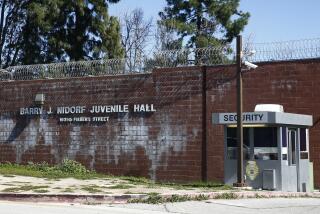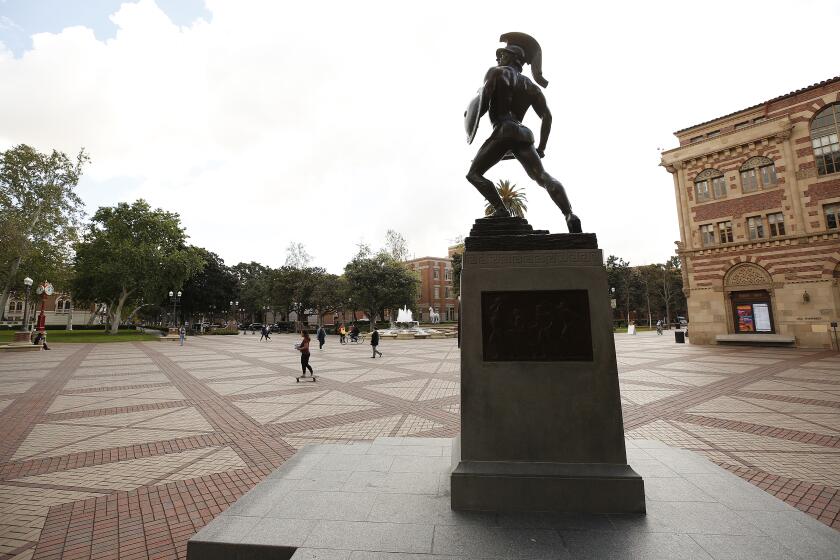L.A.’s prison realignment opportunity
California’s prisons are too full. Indeed, federal courts have found them to be illegally, unconstitutionally overcrowded and have repeatedly ordered the state to address the problem. But even if the courts had not done so, hard economic times and empty state coffers all but demand it.
As the largest single consumer of state prison services, Los Angeles County has at least a moral obligation to help come up with solutions. According to the California Department of Corrections and Rehabilitation, about 54,000 offenders, or a third of all state prison inmates, are from Los Angeles County. Last year, about 19,000 offenders from the county were newly admitted to state prison.
For decades, the state’s nonpartisan Little Hoover Commission and various blue-ribbon panels have proposed moving low-level offenders to county facilities and programs. On Oct. 1, this “realignment” began. Besides bringing the state into compliance with the U.S. Supreme Court decision on overcrowding, the shift to community-based corrections can effectively serve the goals of public safety and eliminate costly, counterproductive, short-term prison stints.
Rather than embrace realignment, however, Los Angeles law enforcement leaders have gone out of their way to distance themselves from it. Just days before the shift began, they claimed to be shocked, shocked that the transfer of low-level offenders, months in the making, was happening at all. Mayor Antonio Villaraigosa and Police Chief Charlie Beck told The Times that it would put an unfair burden on Los Angeles. Dist. Atty. Steve Cooley predicted a crime wave. Sheriff Lee Baca suggested the county would be overwhelmed with new offenders.
The truth is, however, that these concerns have nothing to do with questions of fairness.
Simply because of the county’s size, the realignment population in Los Angeles will be larger than any other county. According to the county’s own realignment plan, about 7,000 offenders who would have gone to state prison each year will instead remain under county supervision. If the county wishes to reduce this number, it may do so by choosing to charge fewer of its residents with low-level offenses.
Nor can L.A. officials claim a lack of space. The county already has about 4,300 empty jail beds, and there are fire camps and community correctional facilities available as other options for housing offenders.
Los Angeles officials also have raised concerns about the number of former offenders who will be returning to the county for local post-release supervision; 1 in 4 parolees statewide already live in L.A. County, and in the first year of realignment, about 9,000 former offenders will be supervised not by state parole agents but by county probation officers.
L.A.’s leaders point out that the money provided by the state — some $124 million for the remainder of fiscal year 2011-12 — will not be enough to provide jail space for all the low-level offenders who previously would have gone to state prison or for all the programs needed for former inmates. They are correct. It won’t be. Like other entitlement programs, the state corrections system has to be cut.
Rather than complain, L.A. leaders ought to lead. If done right, realignment could revolutionize and repair the incarceration-only policies that have led to both the nation’s highest costs per inmate and the nation’s highest state recidivism rate.
Public safety means more than simply jailing offenders. It requires problem-solving courts, the creative use of electronic monitoring and more intensive oversight when offenders have done their time. It means evidence-based, cost-effective strategies such as day-reporting centers, where former offenders must participate in programs during the day but return home at night, and “flash” incarceration, an immediate but short return to jail following a probation violation. It also means drug and mental health treatment for offenders and ex-offenders, as well as education and job training.
To be sure, this is a tough time for Los Angeles County. Its Probation Department is in a period of transition, its Sheriff’s Department is being investigated for excessive force against the offenders it already houses, and budgets are being cut. But however difficult the times and however challenging change is, L.A. County and the rest of California no longer have the luxury of pandering to “tough on crime” policies that have proved ineffective and too expensive to sustain.
Realignment has arrived. Former offenders are already trickling back to L.A. and into county hands. New offenders are being charged. The Los Angeles law enforcement community and the county Board of Supervisors should embrace their new role as a historic opportunity. Public safety is in their hands now more than ever.
Jonathan Shapiro, a former federal prosecutor, is an adjunct professor at the USC School of Law and a member of the Little Hoover Commission.
More to Read
A cure for the common opinion
Get thought-provoking perspectives with our weekly newsletter.
You may occasionally receive promotional content from the Los Angeles Times.










